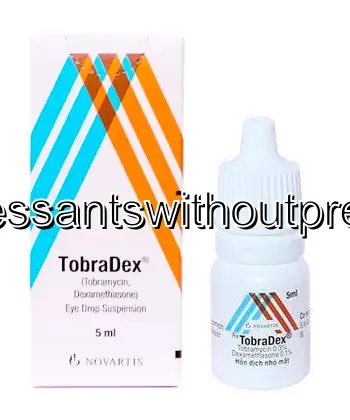| Package | Dosage | Price | Price per Dose | |
|---|---|---|---|---|
| Dosage: 0.1/0.3% | ||||
| 5 bottle | 0.1/0.3% | $73.35 | $14.67 | |
| 4 bottle | 0.1/0.3% | $70.16 | $17.55 | |
| 3 bottle | 0.1/0.3% | $65.38 | $21.79 | |
| 2 bottle | 0.1/0.3% | $59.00 | $29.51 | |
| 1 bottle | 0.1/0.3% | $43.05 | $43.05 | |

Tobradex Description
What is Tobradex?
Tobradex is a prescription eye drop that combines two medicines: tobramycin, an antibiotic, and dexamethasone, a steroid. In the United States the usual form is an ophthalmic suspension containing about 0.3% tobramycin and 0.05% dexamethasone. It is used to treat bacterial eye infections with inflammation, such as conjunctivitis, and to reduce swelling after eye procedures. It should be used under a doctor's instruction and is not for viral infections like a cold in the eye, or for fungal infections.
How I used Tobradex
In my experience, the bottle is typically used 1-2 drops in the affected eye every 4-6 hours for several days. You should follow the exact schedule your doctor gives. Before using, wash your hands, tilt your head back, pull the lower eyelid down, and apply one drop, then close your eye and press gently on the inside corner to limit drainage. Wait a few minutes before using other drops. Do not touch the dropper tip to your eye or any surface. If you wear contact lenses, remove them before use and do not wear them until your doctor says it is OK. Shake the bottle gently if instructed, since it's a suspension. Complete the full course even if symptoms improve to prevent rebound infection or resistance. Do not skip doses or discontinue early without advice.
What I liked about Tobradex
The two-in-one approach is convenient for busy days, since it tackles infection and inflammation at the same time. Many users notice quicker relief from redness, swelling, and irritation, especially after eye procedures. In the United States, Tobradex is commonly stocked in pharmacies and is often covered by insurance when prescribed. The suspension form helps some people with dosing accuracy, and the compact bottle fits easily in a travel kit.
Potential side effects and cautions
Common effects include temporary sting or burning and blurred vision right after application. If these persist, inform your clinician. Prolonged use or high doses can raise eye pressure, increasing the risk of glaucoma, and may contribute to cataract formation or delayed wound healing. There is a risk of fungal or other infections when the immune response is altered. If you have a herpes simplex eye infection, a steroid may worsen it. Seek care promptly if you develop rash, severe itching, swelling, or significant vision changes.
Who should avoid Tobradex and what to discuss with your pharmacist
People with known allergies to tobramycin, dexamethasone, or other aminoglycosides should not use Tobradex. Those with viral infections like influenza in the eye, fungal infections, or corneal ulcers should be evaluated first. Individuals with glaucoma, diabetes, or systemic steroid concerns should discuss risks with their doctor. Pregnant or breastfeeding patients should use Tobradex only if the benefits outweigh potential risks. Tell your pharmacist about other eye medications, steroids, or contact lenses you use, as interactions and dosing considerations can vary in the USA.
In a US pharmacy setting
In the United States Tobradex requires a prescription. Pharmacists can confirm dosing, discuss alternatives such as separate antibiotic and steroid drops, and check for drug interactions. Insurance coverage and out-of-pocket costs vary, with some plans offering better coverage for brand-name Tobradex. Your doctor may tailor the duration of therapy for children and adults, and the pharmacist can provide patient-friendly tips on administration and storage.